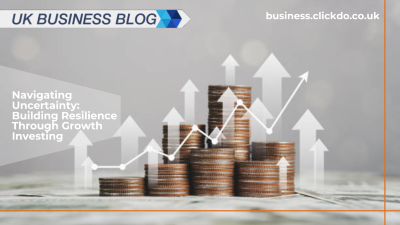Table of Contents
In times of uncertainty, investors often seek strategies that can help them weather the storm and emerge stronger on the other side. One such strategy is growth investing, which focuses on investing in companies that are expected to grow at an above-average rate compared to the overall market.
This article explores the principles of growth investing and how it can help investors build resilience in their portfolios during uncertain times. To delve deeper into the principles of growth investing and its potential benefits, visit this link for a comprehensive guide.
Understanding Growth Investing
Growth investing is based on the principle of investing in companies that have the potential for above-average growth in earnings or revenue. These companies are typically characterized by strong fundamentals, such as a competitive advantage, innovative products or services, and a strong management team. The goal of growth investing is to identify these companies early in their growth cycle and hold onto the investment as the company continues to grow and increase in value.
During uncertain times, growth investing can be particularly beneficial as companies with strong growth potential are often more resilient to economic downturns. These companies are better positioned to weather the storm and emerge stronger when conditions improve. Additionally, growth stocks tend to outperform value stocks during periods of economic expansion, making them an attractive option for investors looking to capitalize on a potential recovery.
Building a Resilient Portfolio
Diversification is a key component of building a resilient growth-focused portfolio. By spreading investments across different asset classes, industries, and geographies, investors can reduce the impact of any one investment on their overall portfolio. This can help protect against losses during periods of market volatility and uncertainty.
Risk management is also critical in growth investing, especially during uncertain times. Investors should carefully consider the risk-reward profile of each investment and ensure that they are comfortable with the level of risk in their portfolio. This may involve setting stop-loss orders, using options to hedge against downside risk, or simply maintaining a well-diversified portfolio.
Asset allocation is another important consideration in building a resilient portfolio. In uncertain times, investors may want to consider increasing their allocation to defensive sectors, such as healthcare or consumer staples, which tend to be more stable during economic downturns. At the same time, maintaining exposure to growth sectors can help capture potential upside when conditions improve.
Growth Opportunities

Identifying growth opportunities in uncertain times can be challenging, but there are several strategies that investors can use to identify potential winners.
One approach is to look for companies that are leaders in their industry and have a track record of strong performance. These companies are more likely to weather the storm and continue to grow in the long term.
Another approach is to focus on companies that are positioned to benefit from long-term trends, such as technological innovation, demographic shifts, or changes in consumer behavior. These companies may be better positioned to adapt to changing market conditions and continue to grow despite economic uncertainty.
Staying Informed and Adapting
Staying informed about market trends and developments is crucial for growth investors, especially during uncertain times. This may involve conducting regular market research, monitoring industry news and developments, and staying up-to-date with company earnings reports and announcements.
Flexibility is also key in growth investing, as market conditions can change rapidly. Investors should be prepared to adapt their investment strategies based on changing market conditions, whether that involves shifting their asset allocation, changing their stock selection criteria, or adjusting their risk management strategies.
Case Studies and Examples
During the financial crisis of 2008, growth stocks outperformed value stocks by a wide margin. Companies like Apple, Amazon, and Google continued to grow their earnings and revenues despite the economic downturn, leading to strong returns for growth investors who held onto their investments.
More recently, during the COVID-19 pandemic, companies in the technology and healthcare sectors have been among the top performers. Companies like Zoom, Moderna, and Amazon have seen their stock prices soar as they have benefited from the shift to remote work and increased demand for healthcare products and services.
Conclusion
In conclusion, growth investing can be a valuable strategy for investors looking to build resilience in their portfolios during uncertain times. By focusing on companies with strong growth potential, maintaining a diversified portfolio, and staying informed about market trends, investors can position themselves to weather the storm and capitalize on potential opportunities when conditions improve.
Author Profile
- Passionate content creator, contributor, freelance writer and content marketing allrounder.
Latest entries
 FinanceMay 9, 2025Oxford Landlords Face Tax Hit as Furnished Holiday Let Benefits End in April 2025
FinanceMay 9, 2025Oxford Landlords Face Tax Hit as Furnished Holiday Let Benefits End in April 2025 FeaturedMarch 11, 2025Why Buying an Electric Car Through Your Business Can Still Have Hidden Tax Benefits Despite New VED Charges
FeaturedMarch 11, 2025Why Buying an Electric Car Through Your Business Can Still Have Hidden Tax Benefits Despite New VED Charges CryptocurrencyAugust 15, 2024The Role of Bitcoin in Sustainable Investment Strategies
CryptocurrencyAugust 15, 2024The Role of Bitcoin in Sustainable Investment Strategies CryptocurrencyAugust 15, 2024Top 6 Bitcoin Investment Opportunities to Watch in Today’s Market
CryptocurrencyAugust 15, 2024Top 6 Bitcoin Investment Opportunities to Watch in Today’s Market






